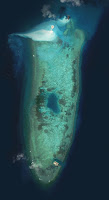By now, most people have gotten wind of the fact that what Obama is up to in Asia is justifying U.S. involvement in every aspect of Asian affairs, particularly in the governance of the sea lanes that connect China, Japan, and their neighbors.
Up north, Obama weighed in on the decades-old standoff between Japan and China over the Senkaku/Diaoyu Islands (north of Taiwan).
Down south, Obama could be expected to do something similar vis-a-vis a China-Philippines standoff over some islands (or "rocks") in the middle of the South China Sea.
However, it seems that the U.S. has grander plans, and it is tipping its hands.
Strategic analysts are pointing out that the South China Sea is an area through which a vast amount of the world's trade passes. And some of them have made the modest suggestion that it would be a good idea for the U.S. to dominate it now, in much the same it dominated the Caribbean at the turn of the 19th century. (Cue images of Teddy Roosevelt and quotes from Admiral Mahan.) (See "The Sea at the Center" and "Straits of Malacca: Obama to Pursue Naval Base Demand")
Herein lies a peculiarly American tendency, for it is one thing to hatch grandiose visions; it is another to actually expect that you are somehow entitled to carry them out; and it is yet another thing entirely to think that you are ever and always the only one entitled to do so.
Related posts
The problem: the U.S. "pivot to Asia."
The opportunity: asking ourselves, "What would we do differently if we revised our myths of Asia?"
(See U.S. Militarism in Asia: THINK DIFFERENT!)
Advocates for human rights in the Philippines, including the Ecumenical Advocacy Network on the Philippines, are asking us to speak out publicly on the need for the U.S. government to "own" its responsibility for human rights violations in the Philippines, and to take affirmative action to halt them. As President Obama begins his trip to Asia -- underlining the much-touted "pivot to Asia" -- it is an especially important time to draw attention to what is really happening in the Philippines.
(See Needed: Less Military Force, More Human Rights in the Philippines )
Many people will argue that it was only because the U.S. made a threat of force that Syria offered to enter into an agreement on chemical weapons. The sequence of events certainly suggests some relationship between the two.
(See "OR ELSE!" (What the U.S. threat of force against Syria teaches us) )
Related links
 |
| before ... |
 |
| ... and after |





No comments:
Post a Comment